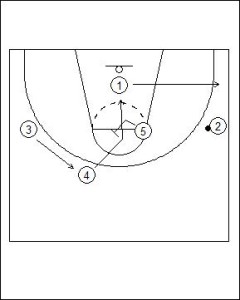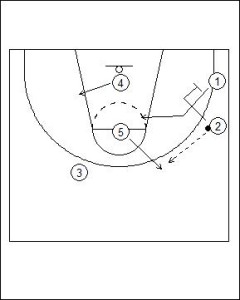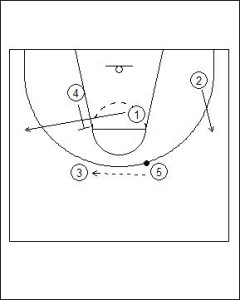UCLA Offense: Dual Point Cut
The UCLA Offense is very effective at using screening actions to create mismatches and advantages for an offense. The UCLA Offense Dual Point Cut Play looks to create space in the middle of the floor by rotating players quickly and then isolating an interior player deep in the post. The UCLA Offense Dual Point Cut Play can be run straight out of a primary transition or as a walk up offense in the half court.

The formation for the offense initially in 4 Out and 1 In. The interior player Five (5) is deep on the basket in a position similar to how many transition offenses finish. From this position, the Five (5) could lift to either side of the floor to initiate the offense.
One (1) makes a pass to Two (2). This pass can be initiated as part of the team’s transition so in effect the cut by One (1) can be started from across halfway. A very effective movement if executed well.
Variation:
If the offense is not being initiated through a transition then the interior player can start on one side of the keyway which allows for Five (5) to flash into the key prior to lifting. If this movement is performed before the pass is made from One (1) to Two (2) then all help defenders will be outside the keyway. Effectively isolating the interior player.
Scoring Options:
- Interior player (Five) on the pass
- One (1) on the UCLA Cut to the basket

One (1) once reaching the front of the basket then moves to the strong side long corner. This movement helps overload one side of the floor by pulling players outside of the keyway in possible help defence position.
Five (5) moves from where the UCLA Cut screen was set (previous sequence) to the split line to set a second screen for Four (4) on the second consecutive cut to the basket.
To provide the best possible angle it would help that when Five (5) goes to set the screen for Four (4) that the screener takes a step towards the basket before moving into the screening position.
Three (3) lifts to the weak side elbow extended.
Scoring Options:
- Four (4) on the cut to the basket
- Five (5) following the screen for high/low set-up in the keyway
- If Four (4) is being fronted and the defence is in full denial then the ball can be reversed to Three (3) on the lift and the pass looking to be made while the defender is on the weak side of the floor

Five (5) lifts to the strong side elbow extended.
Two (2) reverses the ball to Five (5). On the catch Five (5) must square up to the basket and look to engage the defender. This will help pull the defensive player out of the keyway and the cutting area for One (1) later in the play.
Four (4) holds on the basket until Five (5) receives the pass and squares up.
Following the pass to Five (5), Two (2) sets a screen for One (1) in the long corner of the floor.
One (1) cuts towards the keyway aiming to move above the double block and below the high post area of the floor. It is important for the cut not be directly at the basket as Four’s (4) defender will be on the split line and this will not provide enough space for a good quality offensive movement.
By cutting above the double block the help defender on the basket will need to make a choice; stay and allow a close range jump shot or rotate to the ball and leave Four (4) open.
Scoring Options:
- Four (4) on the rim
- One (1) on the mid post cut

Two (2) lifts up the sideline.
One (1) continues the cut through the mid post area and onto the vacant weak side wing position.
Five (5) passes to Three (3) and the offense is now ready to continue on the opposite side of the floor.
As the ball is passed to Three (3), Four (4) lifts into the high postposition.
The UCLA Offense Dual Point Cut Play looks to isolate strong interior players in the keyway. This is a simple movement to try and achieve this, but can be very effective. If a team does not have capable interior players then the UCLA Offense Dual Point Cut Play is not for them.







